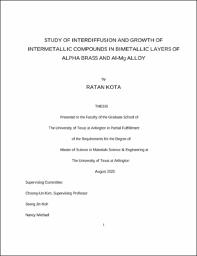
ATTENTION: The works hosted here are being migrated to a new repository that will consolidate resources, improve discoverability, and better show UTA's research impact on the global community. We will update authors as the migration progresses. Please see MavMatrix for more information.
Show simple item record
| dc.contributor.advisor | Kim, Choong-Un | |
| dc.creator | Kota, Ratan | |
| dc.date.accessioned | 2020-09-10T15:33:46Z | |
| dc.date.available | 2020-09-10T15:33:46Z | |
| dc.date.created | 2020-08 | |
| dc.date.issued | 2020-08-17 | |
| dc.date.submitted | August 2020 | |
| dc.identifier.uri | http://hdl.handle.net/10106/29399 | |
| dc.description.abstract | This work aims to study the formation of Inter Metallic Compounds (IMC’s) and their growth rate in Brass and Al-Mg alloy. This diffusion couple consists of four elements Aluminum, Copper, Zinc and Magnesium. Aluminum and Copper are major diffusing elements. Brass-Aluminum bimetal is an advanced structural material and used as a cladding material. This bimetal is produced by cold roll bonding and is mechanically bonded. To increase the adhesive strength of these bimetal layers, the sample is subjected to heat treatment which leads to the formation of Inter Metallic Compounds (IMC). Heat treatments are generally done above the recrystallization temperature of the elements. The recrystallization temperature of the all the four elements with highest melting point is Copper (1085°C) which is about 270°C and the lowest melting point of the four elements is Zinc which is about 420°C. Hence the temperatures in between are good for heat treatment. In this research, temperatures 350°C and 400°C are chosen for heat treatment of samples.
In first part of this research the samples are cut from a cold rolled bonded three-layer brass-aluminum bimetal. These samples are heat treated in a tube furnace at chosen temperatures of 350°C and 400°C for different lengths of times. SEM analysis of the finely polished sample surfaces showed five distinct layers of IMC in between brass and aluminum layers.
In the second part of this work, EDS analysis and XRD analysis is done on samples to find the chemical composition of these identified five layers. It was also observed that the kirkendall voids that were present in the sample coalesced as the heat treatment time increased and formed as a crack. The formation of crack stopped diffusion of elements across IMC’s, when samples were heat treated at 400°C for more than 20 hours. It was also observed that, of the five layers formed, the layer adjacent to α-brass is found to be duplex brass and is formed because of uphill diffusion of zinc and the Mg2Cu6Al5 formed adjacent to CuAl2 is because of uphill diffusion of Magnesium.
In the final part, trend analysis of IMC thickness is done. The obtained data is plotted as thickness vs square root of time. The resulting graphs show that the diffusion across IMC’s follows parabolic law. | |
| dc.format.mimetype | application/pdf | |
| dc.language.iso | en_US | |
| dc.subject | Intermetallic compound | |
| dc.subject | Heat treatment | |
| dc.subject | Diffusion | |
| dc.subject | Uphill diffusion | |
| dc.subject | Growth | |
| dc.subject | Failure | |
| dc.title | STUDY OF INTERDIFFUSION AND GROWTH OF INTERMETALLIC COMPOUNDS IN BIMETALLIC LAYERS OF ALPHA BRASS AND Al-Mg ALLOY | |
| dc.type | Thesis | |
| dc.degree.department | Materials Science and Engineering | |
| dc.degree.name | Master of Science in Materials Science and Engineering | |
| dc.date.updated | 2020-09-10T15:33:47Z | |
| thesis.degree.department | Materials Science and Engineering | |
| thesis.degree.grantor | The University of Texas at Arlington | |
| thesis.degree.level | Masters | |
| thesis.degree.name | Master of Science in Materials Science and Engineering | |
| dc.type.material | text | |
| dc.creator.orcid | 0000-0003-3917-9856 | |
Files in this item
- Name:
- KOTA-THESIS-2020.pdf
- Size:
- 2.084Mb
- Format:
- PDF
This item appears in the following Collection(s)
Show simple item record


